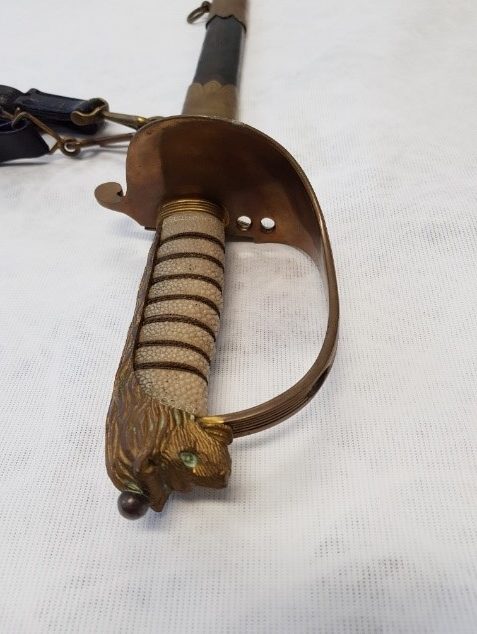British submarine periscope tip
Geelong has a special relationship with submarines. Osborne House in North Geelong was the home of Australia’s first submarine fleet. From 1919-1922, it housed the 6 J Class Submarines gifted to the Australian Government by the Royal Navy. Several hulks of these submarine still survive in Port Phillip Bay. After being decommissioned due to their cost and the economic struggles of the time, four of the boats were scuttled off Barwon Heads. The two other boats were sunk and utilised as breakwaters.

British Torpedo Gyroscope
This is a 1931 British Torpedo Gyroscope made of brass and steel. Most likely from the Royal Gun Factory in Woolwich, it supplied gyroscope to the Royal Navy through World Wars One and Two. The Gyroscope works to keep a fired torpedo aimed straight and towards its target. It has an additional wooden case for transportation that also contains instructions. The case is made from wood, foam, paper and ink. The box includes notched carvings for the gyroscope to sit in for the protection of the delicate instrument in transportation. The box is also designed to have a wall removed for the retrieval of the gyroscope, as shown in the accompanying images.
Navy Shield
Discovered in an antique shop in 1990, this was believed initially to be the 1943 shield of the Navy Patrol Vessel ML 817 but later found to be from the 817 Squadron of the Navy’s Air Arm. Originally a Royal Navy Squadron, the fixed armed aircraft team was transferred to the Royal Australian Navy. Their aircraft operated off HMAS Sydney and HMAS Melbourne, which were aircraft carriers in the late stages of World War Two. Their motto AUDE FACRE means “DARE TO ACT”.

Navy Postcard
This Navy Postcard was the property of Charles Tug Wilson. These postcards were distributed to time poor sailors in order to pass on a message to a loved one without having to take too much time to think of a message. It shows the ways in which defence force staff interacted with the home-front. Did receiving such a postcard carry the same affection as a hand-written postcard?

Service Record of Charles Wilson
Certificate
This paper certificate details the service record from Charles “Tug” Wilson who was training in the Australian Royal Navy during World War 1. It states the vessels he served on and for what period of time. Ships included are the HMS Vivid, HMS Europa, HMAS Platypus, HMS Apollo and HMAS Powerful. Wilson switched between both Australian and British ships during his time of service.
Service Medals
These six medals are part of the Charles “Tug” Wilson collection. From left to right the medals read; MBE, 1914-5 Star, British War Medal WWI, Victory Medal WWI, War Medal 1939-45, and Australian Service Medal 1939-45. The medals were awarded to Wilson in recognition of extensive service to the Royal Australian Navy, achieving the final rank of Lieutenant Commander while serving the nation across multiple decades and conflicts.

Scabbard
In 1913 the Royal Australian Navy inherited the practice of wearing swords for formal dress from the Royal Navy.This sword belonged to Lieutenant Commander Charles “Tug” Wilson. Wilson began with the Royal Navy in World War I and served right through to the Korean War. The sword was well maintained and cared for while it was in service. In recent times, the brass on the hilt is showing signs of oxidisation. This is due to chemical reactions from polishing products historically used on this item during its military service.
Submarines and Auxiliary
Image
Image showing HMAS Platypus (1917) with three of the Royal Australian Navy’s J class submarines. These submarines were based at Osborne House in Geelong between 1920-1922. The Platypus was an auxiliary ship used as a mobile base for submarines.
The Platypus was originally ordered prior to World War I to support the submarines AE1 and AE2, however, it was not completed until after both submarines had been lost. Therefore, the ship was lent to the British’s Royal Navy until the Australian Navy inherited 6 submarines from the British after the competition of World War I.

Model Boat Collection
The Geelong Naval and Maritime Museum holds a significant collection of model boats, including a recently acquired model of the Edina. The GMM collection is partly owned by Geelong City Council, the collection holds items of local, state and national significance. The collection tells important maritime stories, including from the development of the port of Geelong to the development of maritime technology from the mid-19th century, the museum fills a role in educating and giving a sense of pride to the people of Geelong and those visiting the city from abroad.
Rope Board
This rope board is part of the Geelong Maritime Museum collection, a portion of which is owned by the City. Geelong has a rich maritime and cordage industry history. The Geelong Maritime Museum holds items of local, state and national significance.













